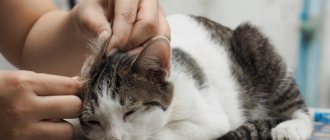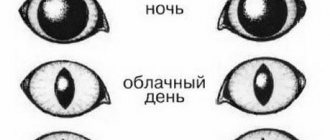Cats and dogs have lips just like humans, although they are usually smaller and not as easy to see! Cats may also not allow you to look at them very closely! The lips are part of what is called the “mucocutaneous junction.” This means that they are the boundary between normal outer skin and the special skin that covers the mouth, eyelids and other internal structures too many to mention!
These joints are susceptible to a variety of problems in all animal species, and swollen lips can be a common symptom of many problems. Read more about what can happen to your cat's lips.
Gingivitis
Gingivitis is an inflammation of the gums in a cat; in the initial stages it occurs as a mild disease.
But if you start the process, then not only the superficial layers of gum tissue are affected, but also the deeper ones. Inflammation affects the ligaments that hold the animal’s teeth in the socket, causing them to fall out. Symptoms:
- Excessive salivation is the very first characteristic sign of the disease; drool is usually viscous and hangs in the form of “icicles”. It is easy to detect in the initial stages of gingivitis in cats and begin treatment on time.
- Swelling – puffiness is a fairly noticeable symptom; the gums begin to “hang” over the teeth.
- Redness – the gums may also have whitish spots or be bluish in color. Upon examination, there will be a bright red stripe on the gums near the base of the teeth. Normally, cats have pale pink oral mucosa.
- Bleeding can be independent and constant, or detected by pressure.
- Strong unpleasant odor from the mouth.
- Severe pain - the cat reacts aggressively to an attempt to examine the mouth, begins to refuse food, and loses weight.
- With ulcerative gingivitis, characteristic ulcers appear on the gums; due to pain, the cat may refuse not only food, but also water.
Treatment:
1. Remove tartar and brush your teeth regularly.
2. Treat the oral cavity with herbal decoctions (oak bark, chamomile) or antiseptic solutions (miramestine, chlorhexidine).
3. Lubricate the gums with dental ointments (Zubastic or Dentavedin).
4. In case of severe inflammation, the veterinarian can prescribe the cat the antimicrobial and antiseptic agent Metrogyl Denta (active ingredients metronidazole benzoate and chlorhexidine gluconate). 5. To speed up the healing of gums, use oil solutions of vitamins A and E, rosehip or sea buckthorn oils, ointments with actovegin or solcoseryl (these substances activate tissue regeneration processes).
===========================================================================================================================================================================================
What to do if your cat has a swollen lip?
If your cat has a swollen lip, it is best to consult your local veterinarian. As stated above, there are many reasons why cats can have swollen lips and it can be very painful and difficult to deal with. For the most accurate diagnosis and the most appropriate treatment, your cat will need professional help as soon as possible. Any delay will cause long-term unnecessary pain and discomfort. The biggest problem is that all of these causes of swollen lips may look very similar, but they all require different treatments, so expert judgment is needed to tell them apart and ensure the right care at the right time.
Home remedies are not suitable given the challenges in diagnosing and treating these problems. Diagnosis is not an easy task, and treatments are specific and can be quite intense depending on the cause of the problem. There are many home remedies available, but in most cases they are either useless or can cause serious harm to your cat, so they are not recommended. At best, they will delay your cat's recovery and thus unnecessarily increase pain. The best and fastest treatment comes after a correct diagnosis by a professional veterinarian.
The only home remedy that might be reasonable to use in some cases is to give the cat time - if you suspect that your cat has had an injury but is otherwise healthy and has slight swelling of the lips due to a cut or blow, then You can't let this fester. unreasonably. However, if your cat appears to be in pain or unwell, again, it is best to seek professional help early on. If your swollen lip doesn't go away within a few days, it's best to seek advice again - the situation may be more complicated than you think.
Article Author: Dr Joanna Woodnutt, (Veterinarian) Joanna is an experienced veterinarian based in the UK. She has written about pets and pet health for many pet websites, blogs and magazines and enjoys helping owners understand their pets through her writing.
Tartar
In fact, tartar is the same plaque, which is a colony of microorganisms that has only undergone calcification. It is quite strong and hard, has a brownish tint and is capable of growing.
Symptoms:
- Finding dark yellow or brown growths on your cat's teeth.
- The appearance of bad breath.
- Bleeding and inflammation of the gums.
- Soreness may appear, the cat may begin to eat poorly, or even lose its appetite.
Treatment:
1. Grinding of teeth with a special paste. Used at the initial stage of the disease.
2. Tartar removal: mechanical or ultrasonic.
============================================================================================================================================================================================
Prevention
Feline calcivirus can be prevented using simple preventive methods:
- A vaccination regimen suggested by a veterinarian can prevent the spread of this disease. Even if the cat never leaves the house, he needs to be vaccinated. If a vaccinated animal gets sick, it will become much easier to treat it, since the symptoms will not be so pronounced.
- Only vaccinated cats should be placed in places where large numbers of animals gather.
- Thorough disinfection of bowls and carriers. Disinfection is carried out with a solution of 1 part bleach to 32 parts water.
Caries
The process of demineralization, accompanied by the destruction of the hard shell of the tooth and the formation of a cavity in its tissues, is called caries.
Caries occurs in several forms, which characterize the depth of damage to hard tissues:
- stage of a light spot (reverse development of the pathological process is possible for unknown reasons) - there are no changes in the structure of the tooth;
- superficial carious process - a dark pigment spot appears on the enamel, the enamel softens;
- with average carious lesions, enamel and dentin suffer;
- deep damage leads to complete damage to the tooth, affecting all its tissues, and attacks of acute pain are possible if hot or cold food comes into contact with the tooth; after the cessation of exposure to the temperature factor, the pain stops.
In the acute course of the pathological process, several teeth may be affected. In this case, the affected areas look like dirty gray spots.
Symptoms:
- decreased pet appetite;
- changes in the cat’s eating behavior (the animal may chew on one side or try to swallow food with minimal chewing movements);
- foul odor from the mouth;
- hypersalivation;
- change in color of the affected tooth;
- pain when chewing.
The cat cannot complain of pain, but will avoid any touching of the sore tooth.
Treatment:
1. At the initial stage, the veterinarian can use local antiseptics:
- silver nitrate;
- sodium fluoride.
2. If the damage is serious, the tooth is removed.
============================================================================================================================================================================================
Symptomatic treatment
If there is any change in the color of the gums, you should take your pet to the vet. Many of the pathologies that are accompanied by a change in the color of visible mucous membranes are serious, some require long-term treatment or emergency care, and some can cause the death of a pet.
The veterinarian will help you correctly determine the cause of the color change and select adequate treatment. In some cases, an ultrasound, complete blood count, computed tomography or x-ray may be required for a more accurate diagnosis.
So, if a foreign body gets in and it is impossible to remove it mechanically, an emergency operation is performed.
For bites and allergic reactions, antihistamines are recommended. In case of poisoning, gastric lavage is effective.
In the case of pathologies of internal organs, the cause that caused the change in gum color is treated. Prescribe a therapeutic diet if necessary.
For diseases of the oral cavity, ointments, sprays and solutions of medications are prescribed. The cat's mouth is treated with cotton swabs.
Injuries are treated locally, decongestants and cold compresses are prescribed to the site of bruises.
Periodontal disease
Symptoms:
- Bad breath. One of the main reasons for visiting a veterinarian. The smell from the mouth becomes unbearable, putrid in nature, and can be felt from afar (when the animal enters the room).
- Decreased appetite. The cat wants to eat, but cannot. Refuses the once-favorite “crackers”, preferring soft food.
- Strange behavior. Owners notice how the pet shakes its head, rubs its muzzle with its paw, as if trying to get something out of its mouth. Sometimes you can clearly hear teeth grinding. The cat slurps when chewing. After eating, the lower jaw may tremble.
- Constant discharge from the mouth. A sick animal will drool profusely. Blood or pus may occasionally leak from the mouth. The fur on the chin is wet all the time, the skin becomes inflamed.
- Tartar and gum inflammation. If the cat is calm, you can move the upper lip and look into the mouth without opening its mouth. It is easy to notice yellow-brown tartar - massive hard deposits that sometimes completely cover the tooth itself. The gums are bright red or bluish in color and bleed. When pressed, a pus-like gray mass may come out from under it.
Treatment:
1. Hygienic cleaning of teeth from plaque and tartar at the initial stage of the disease. After this procedure, the crowns are coated with a fluoride-containing protective varnish. I treat the gums with antiseptic solutions and dental ointments (for example, Metrogil Denta).
2. Surgical intervention.
============================================================================================================================================================================================
Allergy
Another common cause of swelling is an allergic reaction. Swelling and redness of the mouth can be caused by:
- Reaction to insect bites.
- Food allergies.
- Contact dermatitis.
Most often, severe swelling develops from insect bites. The venom of wasps, bees and some types of spiders is a strong allergen, which, when it enters the body, triggers an immunopathological process. Symptoms of insect sting allergy:
- presence of signs of a bite;
- swelling of the skin around the bitten area;
- itching and burning;
- hyperemia and hyperthermia of the skin.
These are symptoms of a common allergic reaction that occurs without complications. In acute allergies, anaphylaxis or Quincke's edema may develop. This is dangerous due to the spread of swelling to the larynx and paralysis of the respiratory tract, which leads to death. Angioedema requires immediate medical attention.
An acute allergic reaction can be recognized by the rapid increase in symptoms. An allergy to insect bites always develops literally a few minutes after the poison enters the animal’s body.
If a cat's lower lip is swollen after changing its diet, it is a sign of food intolerance. This allergy develops slowly as the irritant accumulates in the body. This is manifested by swelling and redness of the rim of the mouth, itching, spots on the ears and around the nose.
Contact dermatitis is a type of allergic reaction that develops as a result of the action of an irritant on the skin. It occurs when household chemicals, medications, or cat cleaning products come into contact with the area around the mouth. The disorder is manifested by skin hyperemia, swelling, itching. The cat becomes restless and scratches the area around its mouth until it bleeds.
In case of allergic reactions, the first thing to do is to interrupt contact with the irritant. If you have food intolerance, you should change the food; if you have dermatitis, you should cleanse the skin of any remaining irritant. Then the animal is given antihistamines, ointments and gels for allergies can be used.
Impact of the virus on people
Sometimes very frightening symptoms spread misinformation about the relationship between people and sick cats. This virus is not at all dangerous for owners, moreover, it will not cause any harm to dogs, horses and other animals. This strain is only related to cats. There is no need to be afraid of a sick pet; it needs to be treated; it needs the support and care of its owner.
All infections that affect an animal’s immune system are dangerous for it, but if you notice the symptoms in a timely manner and begin treatment, you can cope with this disease.
Forms of the disease
A severe form of the disease is the plasmacytic-lymphocytic form . It is caused by various viruses - rhinotracheitis, panleukopenia, hyperreaction of the immune system. This form has complications. The gums begin to bleed and swell. Without treatment, complications develop.
The dental form of the disease is accompanied by sore gums, bleeding and swelling. Diseased tissues become bluish in color. The submandibular lymph nodes begin to swell. Unlike the plasmacytic form, the disease is caused not by a virus, but by accumulated plaque. The dental form is treated faster and rarely causes complications.
Juvenile gingivitis is a form of the disease characteristic of cats under the age of 1.5 years, also called juvenile gingivitis. Inflammation of the gums and pharynx occurs immediately after the eruption of permanent teeth. If left untreated, periodontitis may develop.











